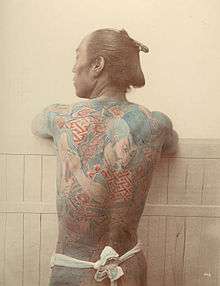Bakuto
Bakuto (博徒) were itinerant gamblers active in Japan from the 18th century to the mid-20th century. They were one of two forerunners (the other being tekiya, or peddlers) to modern Japanese organized crime syndicates called yakuza.[1][2][3]
History
Beginning around the 17th century, bakuto plied their trade in towns and highways in feudal Japan, playing traditional games such as hanafuda and dice. They were considered social outcasts, living outside the laws and norms of society.[3]

During the Tokugawa shogunate, violent bakuto ikka (families) rose to power with the gambling spaces they ran, occasionally hired by local governments to gamble with laborers, winning back worker's earnings in exchange for a percentage. They had varying qualities of relationships with the villages in which they lived, often as well with the government despite their connection.[1][3]
In the 18th century, the tradition of elaborate tattooing was introduced into bakuto culture. Dealers of card or dice games often displayed these full-body tattoos shirtless while playing. This eventually led to the modern yakuza tradition of full-body tattooing.[1][4] Bakuto were also responsible for introducing the tradition of yubitsume, or self-mutilation as a form of apology, to yakuza culture.[3][4][5]
As the bakuto organized into groups and expanded into other operations such as loan sharking, half of the groundwork for the modern yakuza was born.
Bakuto were responsible for coining the term "yakuza" for themselves, a homonym for "ya-ku-sa", a losing hand in card games. "Ya-ku-sa," synonymous with "useless", was meant to symbolize society's dislike for them.[3]
Up until the mid-20th century, some yakuza organizations that dealt mostly in gambling described themselves as bakuto groups. But this was seen as outdated, and most were eventually absorbed into larger, more diverse syndicates. For example, the Honda-kai was a Kobe-based bakuto gang which formed an alliance after World War II with the Yamaguchi-gumi, but were soon overtaken by the larger gang.
Notable figures
Kunisada Chuji was a notable bakuto ikka boss. His story is mainly responsible for the romanticized "chivalrous bandit" image. He was publicly executed in 1850 for various crimes after a large man-hunt.[1]
In popular culture
Fictional examples can be seen in the Zatoichi and iron fist film series, about a blind masseur who would often participate in bakuto-run gambling.[6]
From 1964 to 1971, Toei Studios produced the ten-part Gambler (Bakuto) series of films starring Kōji Tsuruta (except for the film Gambler Clan, which starred Ken Takakura in his place).[7]
The 1968 movie series Red Peony Gambler (Hiboten Bakuto), starring Sumiko Fuji, also references bakuto culture.[8]
References
- Maruko., Siniawer, Eiko (2009-01-01). Ruffians, yakuza, nationalists : the violent politics of modern Japan, 1860-1960. Cornell University Press. ISBN 9780801447204. OCLC 475533274.
- Goodman, Lecturer in the Social Anthropology of Japan Roger; Goodman, Roger; Refsing, Kirsten (2002-09-11). Ideology and Practice in Modern Japan. Routledge. ISBN 9781134927128.
- Fisher, Eliza (2012). "From Outcasts to Overlords: The Legitimation of the Yakuza in Japanese Society". The Undergraduate Journal of Social Studies. 3: 12.
- ASIAN ORGANISED CRIME IN AUSTRALIA: A Discussion Paper by the Parliamentary Joint Committee on the National Crime Authority. Canberra, Australia. 1995. ISBN 0-642-22448-X.
- N. Bosmia, Anand; J. Griessenauer, Christoph; Tubbs, R Shane (2014). "Yubitsume: ritualistic self-amputation of proximal digits among the Yakuza". Journal of Injury and Violence Research. 6 (2): 54–6. doi:10.5249/jivr.v6i2.489. PMC 4009169. PMID 24284812.
- Kitano, Takeshi; Asano, Tadanobu; Ohkusu, Michiyo; Guadalcanal, Taka (2003-09-06), The Blind Swordsman: Zatoichi, retrieved 2017-03-07
- Chris, D. (2005-05-27). Outlaw Masters of Japanese Film. ISBN 9781845110901.
- Fuji, Sumiko; Araki, Masako; Arishima, Junpei; Awaji, Daisuke (2012-01-28), Red Peony Gambler, retrieved 2017-02-27
- Kaplan, David E., and Alec Dubro. Yakuza: Japan's Criminal Underworld, exp. ed. Berkeley: University of California Press, 2003. ISBN 0-520-21561-3, ISBN 0-520-21562-1.